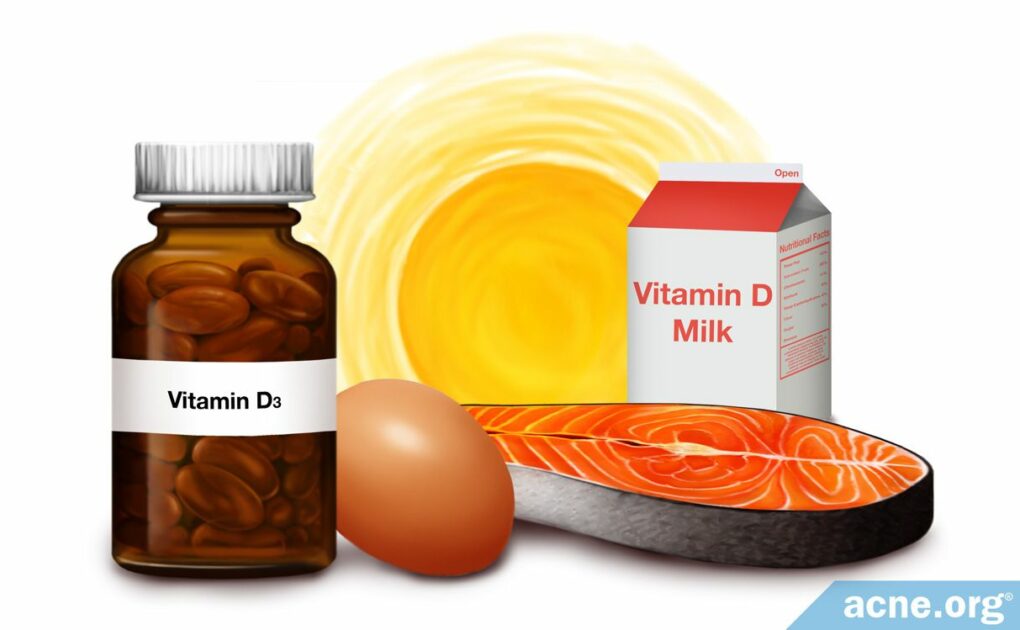Regular, Brief Periods of Sun Exposure Are Best

The Essential Info
Vitamin D is essential to both skin health and overall health, and vitamin D deficiency might lead to more severe acne symptoms.
Vitamin D deficiency is common worldwide, particularly:
- At higher latitudes (further from the equator)
- During winter
- In darker-skinned people
- In people who stay indoors a lot
- In people who constantly protect themselves with sunscreen and/or clothing
Get Some Sun: The best and most efficient method of getting enough vitamin D is through regular, brief periods of sun exposure. This equates to 20 minutes per day for the lightest-skinned people and 2+ hours per day for the darkest-skinned people.
If You Can’t Get Sun, You Can Supplement: When it is not possible to get enough vitamin D through sun exposure, many doctors recommend 800 – 1000 IU per day of vitamin D3, which can be easily found at any drugstore or supermarket.
How Do You Know if You Are Low in Vitamin D? Low levels of vitamin D are extremely common in today’s indoor-centric world. Given the high prevalence of vitamin D deficiency, it is a good idea to get a quick blood test to determine if you have adequate levels of vitamin D. These tests are routine and your doctor can order one up very easily. I had a vitamin D blood test done myself, and lo and behold, I was borderline deficient. After a few weeks of supplementation, I was back where I needed to be. Now I try to remember to soak up the sun a little more often, and when I don’t, I pop a vitamin D3 pill. Easy peasy.

The Science
- Vitamin D Is Essential for Skin Health and Overall Health
- Vitamin D Deficiency Is Common Worldwide
- Getting Vitamin D Through Sun Exposure
- Through Food
- Through Supplements
- Is It Possible to Get Too Much Vitamin D?
- Conclusion
Vitamin D Is Essential for Skin Health and Overall Health
The color of our skin is the direct result of our ancestral need for vitamin D. The lighter the skin, the more easily that skin can produce vitamin D. Since humans historically got vitamin D almost entirely through sun exposure, and only got a small fraction of their vitamin D needs through food, as humans migrated north out of Africa, their skin became lighter in order to allow for more vitamin D production.
When it comes to acne in particular, vitamin D may help heal acne lesions and deficiencies in vitamin D might play a role in the development or worsening of acne.
Vitamin D is actually a hormone, which is extremely important to normal body functions and in the prevention of skin disease and other diseases. This point is reiterated in the following 2006 article published in Progress in Biophysics and Molecular Biology:

Authors of this study relay the fact that many human and laboratory studies have shown a clear “connection between vitamin D deficiency and a broad variety of independent diseases, including various types of cancer, bone diseases, autoimmune diseases, hypertension and cardiovascular disease.”1
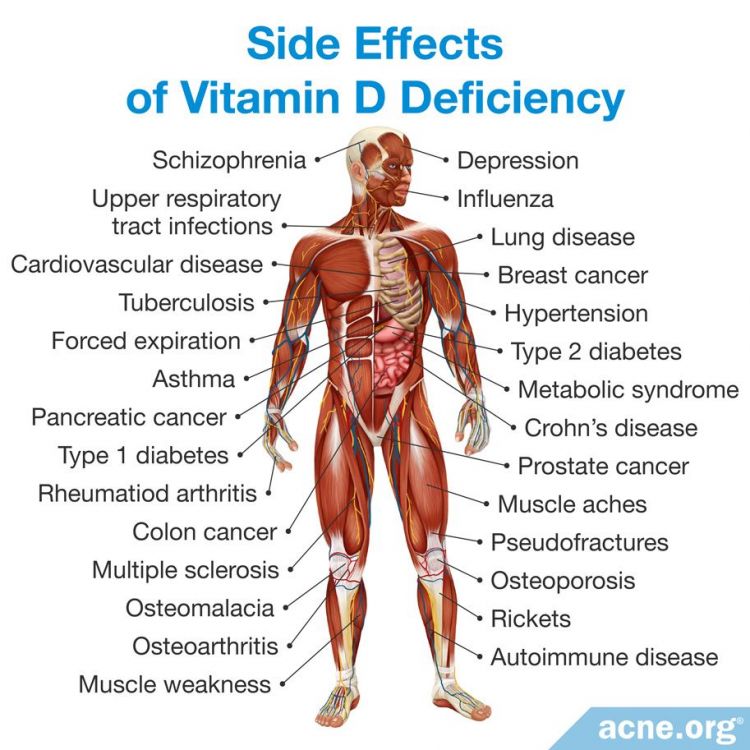
Vitamin D Deficiency Is Common Worldwide
Many people do not get enough sun exposure because they live in high latitudes where the sun is weaker, because of darker skin tones, or because they are protecting their skin from the sun’s UV (ultraviolet) rays. For all of these reasons vitamin D deficiency is common worldwide.
The following studies show us that a striking number of people are deficient, with numbers hovering around 50% or more in populations.

A 2014 article in the Journal of Human Nutrition and Dietetics found a high prevalence of vitamin D deficiency in Europe, especially in northern latitudes. After looking at various statistics from several organizations, the authors noted a wide range of vitamin D deficiency percentages in these higher latitudes, from 36% to 73%.2

According to a 2011 study in The Journal of Clinical Endocrinology & Metabolism, “Vitamin D deficiency is common in Australia, the Middle East, India, Africa, and South America…In the United States, more than 50% of Hispanic and African-American adolescents in Boston…and 48% of white preadolescent girls in Maine had [vitamin D deficiency]. In addition, 42% of African-American girls and women aged 15 – 49 [years] throughout the United States had [vitamin D deficiency] at the end of the winter, and 32% of healthy students and physicians at a Boston hospital [were deficient in vitamin D]. Pregnant and lactating women who take a prenatal vitamin and a calcium supplement with vitamin D remain at high risk for vitamin D deficiency.”3
Exactly What Is Vitamin D Deficiency?
Vitamin D deficiency means that blood levels of vitamin D are too low. From the research we have thus far, keeping your vitamin D levels between 30 ng/ml (nanograms per milliliter) to 50 ng/ml is the sweet spot. A blood test can determine if a patient is deficient in vitamin D. According to the current guidelines on blood levels of vitamin D:
- Less than 20 ng/ml indicates deficiency.3
- Between 20 and 29 ng/ml indicates insufficiency.3
How is vitamin D deficiency or insufficiency treated?
Low levels of vitamin D can be both treated in three ways:
- Increasing sun exposure
- Increasing the consumption of foods that contain vitamin D
- Taking vitamin D supplements
Getting Vitamin D Through Sun Exposure
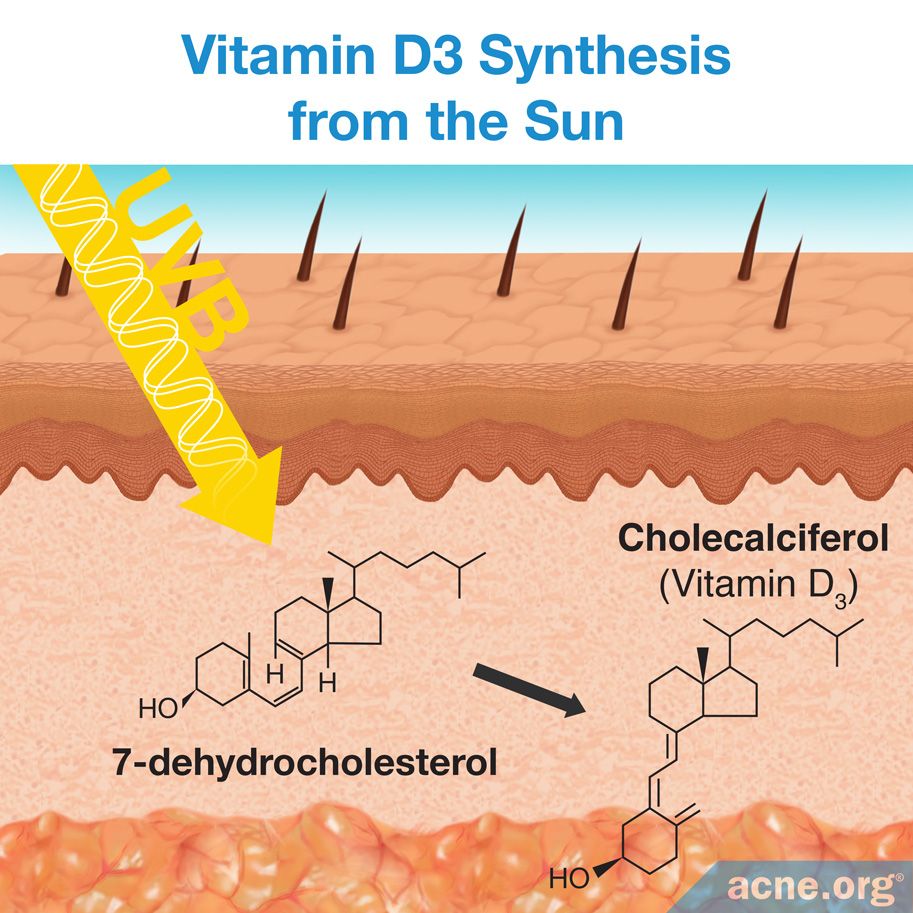
Before recommending supplements, doctors consider whether enough vitamin D can be attained through natural sources, namely exposure to sunlight and eating foods that are rich in vitamin D.
Regular, brief sun exposure is the fastest and most efficient way to achieve ideal vitamin D levels, and as a 2011 study in The Journal of Clinical Endocrinology & Metabolism shows us, vitamin D that is produced in the skin through exposure to sunlight “may last at least twice as long in the blood compared with ingested vitamin D.”3
However, getting enough sun exposure can be difficult, partly because in modern society we spend much of our time indoors. Also, because excess sun exposure causes skin cancer, doctors recommend limiting the time spent in the sun and protecting the skin with sunscreen and clothing.
Two 2006 articles published in Progress in Biophysics and Molecular Biology recognize this challenge and encourage balancing efforts toward preventing skin cancer and the need for adequate levels of vitamin D by getting regular, short periods of exposure to the sun.
Expand to read recommendations from these articles

Unfortunately, the same measures that protect the skin from sunburn and cancer also prevent the synthesis of vitamin D. A 2006 article in Progress in Biophysics and Molecular Biology noted that “[w]e and others have shown that strict sun protection causes vitamin D deficiency in risk groups.”1The authors suggested that in order to balance the numerous health risks associated with low vitamin D with the serious risks of excessive sun exposure, “Well-balanced recommendations on sun protection have to ensure an adequate vitamin D status, thereby protecting people against adverse effects of strict sun protection without significantly increasing the risk of developing UV-induced skin cancer.”1

The best way to balance the risk of vitamin D deficiency with the risk of skin cancer is to get a small amount of unprotected sun exposure on a regular basis and to wear protective clothing and sunscreen during any additional time spent in the sun. A 2006 article in Progress in Biophysics and Biology noted that prolonged exposure to sunlight does not provide any benefits over shorter exposure times as there is a limit to the vitamin D production process after which no more active vitamin D can be produced, and in fact, excessive sun exposure can actually destroy vitamin D.4 The authors commented, “The best way to increase vitamin D status is by short, regular exposures of unprotected skin to sunlight…Thus a regular daily exposure is far more effective than a single long exposure once a week. Short regular exposures will also prevent sunburn and the associated discomfort and long-term risks.”4
So how do you get the right amount of sun exposure?
An article published in Mayo Clinic Proceedings in 2012 argues that for a fair-skinned person, 10-15 minutes of exposing the face, arms, and hands to the sun at midday should allow the body to produce enough vitamin D.5 Darker skin needs more time in the sun to produce the same amount of vitamin D. In fact, people with very dark skin may require upwards of 2 hours in the sun daily.
However, determining the optimal amount of sun exposure is difficult because many factors influence how much vitamin D the body can produce during a given amount of sun exposure, including:
- Latitude (how far from the equator you live)
- Season
- Cloud cover
- Time of day
- Altitude
- Skin pigmentation
- Amount of skin exposed
- Whether sunscreen or protective clothing is used or not
Because of the many factors involved, it is nearly impossible to predict the exact amount of sun exposure a person needs. Instead, as a general rule, doctors recommend getting regular, short periods of sun exposure, and never burning the skin. In other words, try to expose your skin to the sun on a daily basis for a short amount of time, and always stop before you get too pink or burn.
Expand to go through each of these factors one by one
Now, let’s go through each of these factors one by one.
Latitude
Near the equator, the sunlight is relatively consistent year round. However, the further you get from the equator, the more variation there is when it comes to sunlight. According to a 2006 article in Progress in Biophysics and Molecular Biology, “It is noticeably more difficult for individuals living at latitudes far from the equator to maintain healthy levels of vitamin D during fall, and winter, if they depend primarily on solar exposures…Such individuals may need to supplement their vitamin D levels.”6
Season
The sun is much stronger during late spring, summer, and early fall. Therefore, much less sun exposure is required during this time to achieve adequate vitamin D. Here are two articles and one study that explore seasonal variation in sun exposure in greater depth:

At higher latitudes, the time of year affects how much vitamin D the body can produce during a given period of sun exposure. You want to get enough sun to produce vitamin D, but not so much that you start to get red and burned. A 2006 article in Progress in Biophysics and Molecular Biology noted that at a middle latitude, “In the summer, the significant short-wavelength (UV-B) radiation at midday can produce [sunburn] in sensitive skin in less than 20 min…and yet in winter months, the same midday exposure dose would require hours of exposure.”6

At middle latitudes in the Northern Hemisphere, there are effectively only two seasons because the amount of radiation available for vitamin D production shifts so quickly during the few weeks surrounding the spring and fall equinoxes in March and September. A 2006 article in Progress in Biophysics and Molecular Biology commented, “The public should understand that the UV climate changes rapidly in March in the Northern Hemisphere and sunburns are likely in early spring if not prepared. Likewise, the UV available for Vitamin-D production suddenly drops in September and remains virtually unavailable during most fall and winter months.”6

A 2013 study in the journal Endokrynologia Polska noted that in Central Europe, adequate sunlight for vitamin D photosynthesis occurs between the end of April and the beginning of September, and from October to March, efficient production of vitamin D is not possible. The authors noted that between April and September, “In practical terms, exposing 18% of the body to the sun without sunscreen for approximately 15 minutes a day between 10 a.m. and 3 p.m. is likely to be adequate for fair-skinned Central Europeans.”7
Cloud Cover
The amount of cloud cover on a given day also affects the amount of vitamin D the body can produce during sun exposure since clouds absorb UV radiation. According to a 2006 article in Progress in Biophysics and Molecular Biology, “A thick layer of stratus cloud covering the whole sky (“heavy overcast”) will strongly reduce the radiation, including UV, at the surface.”5
Time of Day
The closer to noon, the stronger the sun’s rays. The angle at which sunlight reaches Earth’s surface at any given time of the day is called the solar zenith angle. This angle is highest at noon, meaning the most UV radiation is available. The farther away from noon, the lower the solar zenith angle and the less radiation that is available for vitamin D synthesis.5
Altitude
The sun is stronger at higher altitudes, because there are fewer pollutants and other particles in the air for UV radiation to travel through, so more radiation reaches the skin.5
Skin Pigmentation
Darker-skinned people are better protected from the damaging effects of the sun, but also absorb less of the sun’s radiation and are therefore at greater risk of vitamin D deficiency. As a 2006 article in Progress in Biophysics and Molecular Biology noted, “The very skin types most resistant to the harmful effects of UV radiation are also the ones most associated with diseases of vitamin D deficiency.”8
Amount of Skin Exposed
The more skin that is exposed, the more radiation it absorbs and therefore, the more vitamin D that can be produced. For example, according to a 2006 article in Progress in Biophysics and Molecular Biology, “exposing a (bald) head and neck to sunlight for 20 min would produce about the same vitamin D as exposing the full body for 2 min.”5 The authors noted that clothing and sunscreen both are barriers that affect the amount of sunlight that reaches the skin, and that “for efficient…vitamin D synthesis, unprotected skin should be exposed to solar radiation.”5
Getting Vitamin D Through Food
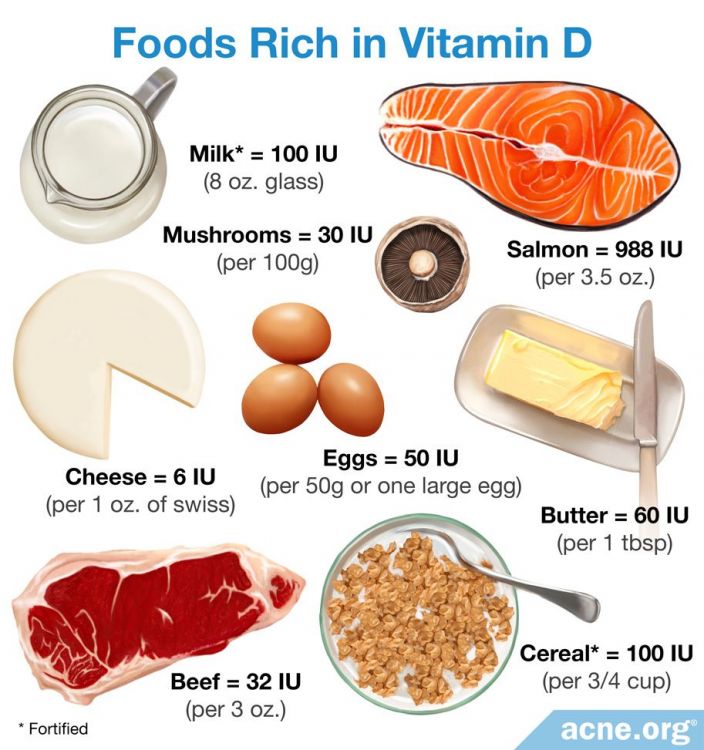
It is also possible to get some vitamin D through some foods, namely fatty fish, fortified milk, and other fortified foods containing vitamin D, but the amount of vitamin D in these foods is far less than the amount that the skin produces when exposed to sunlight, by an order of magnitude.8
Eating a diet rich in these foods can help increase vitamin D levels but by itself is unlikely to be enough to correct or prevent vitamin D deficiency.
Getting Vitamin D Through Supplements
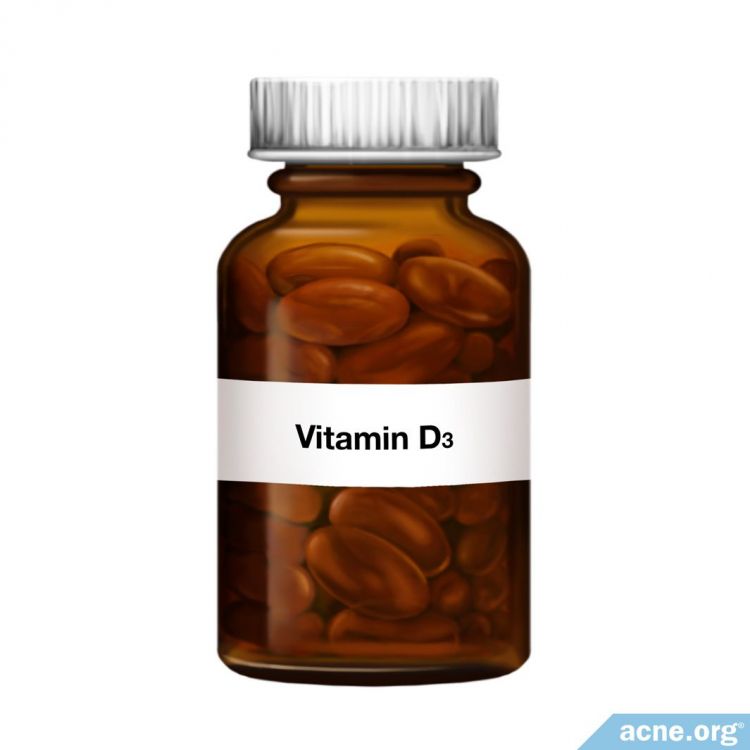
When exposure to sunlight and eating foods rich in vitamin D are not enough to achieve adequate vitamin D levels, doctors recommend taking vitamin D supplements.
There is no consensus on how much vitamin D is safe or optimal, and recommendations for specific groups and individuals vary, but many scientists and clinicians recommend 800 – 1000 IU (international units) of supplemental vitamin D per day as a guideline, and some scientists and doctors recommend up to 2000 IU per day.7,8
Vitamin D supplements do not necessarily have to be taken daily because vitamin D is fat soluble and therefore accumulates in the body’s fat tissue and can be stored for around four to six weeks.7
Here are some more detailed recommendations regarding vitamin D supplementation from the Journal of Adolescent Health:
Expand to read recommendations

Adolescents are at particularly high risk for vitamin D deficiency, and this deficiency can have severe and long-lasting effects on bone formation. As a 2013 study in the Journal of Adolescent Health noted, “Even subclinical deficiency during adolescence may affect bone acquisition, potentially reducing peak bone mass and increasing the risk of osteoporosis in later life. Current evidence suggests that giving vitamin D supplements to adolescents who are vitamin D deficient may improve their bone mineral density as well as increase their total bone mineral content. There is also recent evidence to suggest that an adequate vitamin D intake is associated with decreased stress fracture risk among physically active females.”9
The Society for Adolescent Health and Medicine Recommendations, published in 2013 in the Journal of Adolescent Health, suggests that healthy adolescents supplement with 400 – 800 IU of vitamin D daily, and that adolescents who are at high risk of deficiency take at least 1000 IU daily, in addition to eating foods that are high in vitamin D. For teens that are have insufficient levels of Vitamin D but are not yet deficient, the Society recommends supplementing with at least 1000 IU per day for at least three months. For teens that are already deficient in vitamin D, the Society recommends treating with 50,000 IU of vitamin D once a week for 8 weeks.9 However, since vitamin D can become toxic over 40,000 IU per day, it is important to only take high levels under a doctor’s supervision.
Is It Possible to Get Too Much Vitamin D?
While uncommon, too much vitamin D is toxic and can cause abnormally high concentrations of calcium in the blood, which can result in nausea, constipation, abnormal heart rhythms, and kidney stones. However, this is only an issue with oral vitamin D supplementation. When exposed to the sun, the body has an automatic shut-off mechanism, which allows for the ideal amount of vitamin D.
Conclusion
Vitamin D is essential for both skin health and overall health. Vitamin D may even help heal acne lesions and may play a role in the development and treatment of acne.
Getting a healthy dose of vitamin D through sun exposure is best, but can be limited by a number of factors, including latitude, season, cloud cover, time of day, altitude, skin color, and amount of skin exposed. Therefore, for some people, supplementation may be essential to maintaining overall health and, for acne sufferers in particular, skin health.
To determine your vitamin D level and get a medically-sound recommendation for exactly how much vitamin D to supplement, make an appointment with your doctor for a standard blood test. It’s quick and easy.
References
- Reichrath, J. The challenge resulting from positive and negative effects of sunlight: how much solar UV exposure is appropriate to balance between risks of vitamin D deficiency and skin cancer? Prog Biophys Mol Biol 92, 9 – 16 (2006). https://www.ncbi.nlm.nih.gov/pubmed/16603232
- Cashman, K. D. & Kiely, M. Recommended dietary intakes for vitamin D: Where do they come from, what do they achieve and how can we meet them? J Hum Nutr Diet 27, 434 – 442 (2014). https://www.ncbi.nlm.nih.gov/pubmed/24580775
- Holick, M. F. et al. Evaluation, treatment, and prevention of vitamin D deficiency: an Endocrine Society clinical practice guideline. J Clin Endocrinol Metab 96, 1911 – 1930 (2011). https://www.ncbi.nlm.nih.gov/pubmed/21646368
- Webb, A. R. Who, what, where and when-influences on cutaneous vitamin D synthesis. Prog Biophys Mol Biol 92, 17 – 25 (2006). https://www.ncbi.nlm.nih.gov/pubmed/16766240
- Vanchinathan, V. & Lim, H. W. A dermatologist’s perspective on vitamin D. Mayo Clin Proc 87, 372-380 (2012). https://www.ncbi.nlm.nih.gov/pubmed/22425213
- Sliney, D. H. & Wengraitis, S. Is a differentiated advice by season and region necessary? Prog Biophys Mol Biol 92, 150 – 160 (2006). https://onlinelibrary.wiley.com/doi/abs/10.1111/j.1600-0781.2009.00442.x
- Garanty-Bogacka, B. et al. Association between serum osteocalcin, adiposity and metabolic risk in obese children and adolescents. Endokrynol Pol 64, 346 – 352 (2013). https://journals.viamedica.pl/endokrynologia_polska/article/view/36132
- Scarlett, W. L. Ultraviolet radiation: sun exposure, tanning beds, and vitamin D levels. What you need to know and how to decrease the risk of skin cancer. J Am Osteopath Assoc 103, 371 – 375 (2003). https://jaoa.org/article.aspx?articleid=2092912
- Society for Adolescent, H. & Medicine. Recommended vitamin D intake and management of low vitamin D status in adolescents: a position statement of the society for adolescent health and medicine. J Adolesc Health 52, 801 – 803 (2013). https://www.ncbi.nlm.nih.gov/pmc/articles/PMC4971599/
 Acne.org Products
Acne.org Products